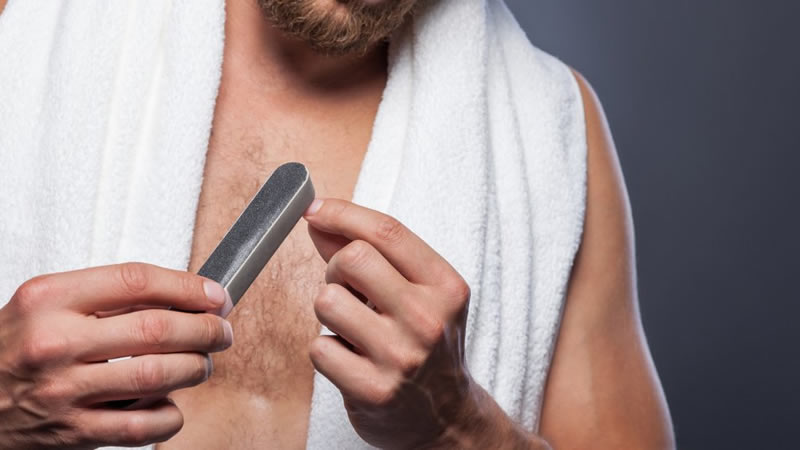Here’s Why Men Should Get Manicures, According to Experts

Can you think of a time in recent memory when taking care of our hands wasn’t as important as it is now? We’ve all spent more than a year focused on constant washing, sanitizing and, in some cases, glove wearing to keep our hands clean and our bodies healthy. All that hand washing has brought renewed focus to our hands and exacerbated issues like dryness and cracking. Plus, coming off winter, which is always harsh on hands, has only made these issues worse.
But that question I posed earlier is kind of a trick. Sure, washing your hands is essential right now, but hand care is always important. If anything, the hand washing bonanza we’ve been experiencing has made us “become aware of how much we have not taken care of our hands,” says manicurist Deborah Lippmann. The reason we often overlook our hands in our overall grooming routine is because we treat them as tools. “They clean, they do yard work, they do this, they do that,” she says. They’re the most used part of our body, yet we don’t often think they need to be treated with care.
And when it comes to hand care, a manicure is the gold standard. Manicures are about taking care of the entire hand, not just the nails, and can help improve the look of hands exponentially. Getting regular manicures and even wearing clear polish to protect your nails—which the Army just updated their dress code to allow—isn’t just about how your hands look, though. They can also help keep your hands healthy.
Nail Care Is Part of Hand Care
Having hydrated hands is only part of hand care, and the reason manicures focus so much on nails isn’t just for aesthetic reasons. Keeping your nails in check also helps them stay strong and keeps the delicate skin around them—called the cuticle—healthy. Your cuticle is one of the few places on your body where the skin actually ends, says Lippmann, so when it dries out it can rip and tear, causing painful hangnails. Hangnails aren’t just uncomfortable; they “can be a portal of entry for infection,” says New York-based dermatologist Ryan Turner, M.D. Just like when your hands crack, hangnails or cuts around your nails can let in bacteria and fungus. Fungal infections are particularly common around your nails and should be treated by a dermatologist, but the best thing to do is prevent them in the first place by keeping your cuticles hydrated and hangnail-free. If you already have hangnails, cut them off with a nail scissor—never, ever bite them with your teeth, says Lippmann.
Without regular upkeep, nails can also become weak. Weak nails can have a dull, powdery white or yellow appearance, says Dr. Turner, which of course doesn’t look great, but weak nails also break more easily, which can be painful especially if they break or tear far enough to expose the nail bed. Sometimes weak nails are caused by nutritional deficiencies (something you can ask your dermatologist about), but in many cases, Dr. Turner recommends a clear coat of polish (like OPI Natural Nail Strengthener) which can help keep weakened or brittle nails protected.
Manicures for Men 101
The best way to keep both your hands and nails in check is to get regular manicures. Going to a nail salon to get a professional job is great—just make sure they open a new pack of tools in front of you and the license of the person working on you is clearly displayed. Even semi-regular professional manicures can make a huge difference in the health of your hands and nails. But if you can’t make it to a professional, aren’t comfortable or just want upkeep between visits, manicures are also easy to do yourself in the comfort of your own home. Here’s how.
- Clip your nails with a nail clipper, starting with the sides of the nail, to your desired length.
- Use an emery board or nail file to smooth out the cut edge of the nail. Always move the file in one direction. “Don’t go back and forth with your file because that will cause the nails to peel,” says Lippmann.
- Apply cuticle remover to the edges of your nail where it touches the skin. Then use an orange stick or cuticle pusher to gently push back the cuticle from the surface of the nail. “Use little circles from the side of the nail to the tip,” says Lippmann. You’ll see skin gently lift off the nail “like exfoliating your face.”
- Use a tiny bit of cuticle oil to moisturize the cuticle. “Any time you put moisture on your cuticles, your nails will be in better shape,” Lippmann advises.
- If your hands look dry or ashy, use a hand scrub to remove the dead skin from all over your hands. “It takes off some of the calluses that build-up,” she says.
- After the scrub (or in place of it you’re skipping that step), apply a moisturizing hand lotion or cream. Make sure to massage it into the cuticles around your nails and between your fingers.
- Use a bit of nail polish remover or Sea Breeze on a cotton ball to clean off just the plate of the nail, but leave the cuticles and skin alone (the alcohol will dry it out).
- If you want, use a buffer to buff your nails till they shine (how much shine is up to you). For even more shine, and added protection if you have weak nails, this is where you would apply clear polish (or colored polish if that’s your vibe).




